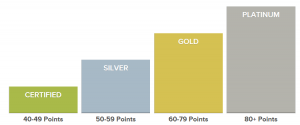Developed by the U.S. Green Building Council (USGBC) in 1998, LEED (Leadership in Energy and Environmental Design) is the industry standard for measuring building sustainability. The overall goal of the program is to help building owners become more environmentally responsible and leaders in energy efficiency.
LEED 2009 set the standards for minimum program requirements. Under the 2009 guidelines, a building:
- Must comply with environmental laws
- Must be a complete, permanent building or space
- Must use a reasonable site boundary
- Must comply with minimum floor area requirements
- Must comply with minimum occupancy rates
- Must commit to sharing whole-building energy and water usage data
- Must comply with a minimum building area to site area ratio.
Following these minimum guidelines, LEED 2009 established a point system that acts to align and weigh credits based on varied sustainability factors set forth by the EPA (Environmental Protection Agency). The four levels include Certified, Silver, Gold, and Platinum

Credits are acquired by satisfying prerequisites. The more points each building satisfies under each category, the higher its certification level can grow. The credit categories include:
- Integrative Process
- Location and transportation
- Materials and resources
- Water efficiency
- Energy and atmosphere
- Sustainable sites
- Indoor environmental quality
- Innovation
- Regional priority credits
The USGBC also offers LEED credentials for working professionals, many that span across different industries. Individuals can take an exam and qualify for:
- Green Associate
- AP Building Design + Construction (LEED AP BD+C)
- AP Operations + Maintenance (LEED AP O+M)
- AP Interior Design (LEED AP ID+C)
- AP Neighborhood Development (LEED AP ND)
- AP Homes



